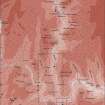Billholm
Fort (Prehistoric)
Site Name Billholm
Classification Fort (Prehistoric)
Alternative Name(s) River Esk
Canmore ID 67315
Site Number NY29SE 20
NGR NY 27929 92019
Datum OSGB36 - NGR
Permalink http://canmore.org.uk/site/67315
- Council Dumfries And Galloway
- Parish Westerkirk
- Former Region Dumfries And Galloway
- Former District Annandale And Eskdale
- Former County Dumfries-shire
Poorly preserved remains of probable later prehistoric settlement located in an escarpment on a bend in the River Esk within rough pasture and partially overlain by mixed woodland. Localised setting to river valley.
information from Héléna Gray, (CFA Archaeology Ltd), August 2015
OASIS ID: cfaarcha1-278420
NY29SE 20 2795 9205.
(NY 279 920). An earthwork at Billholm has three closely set ditches and banks which cut off the promontory formed by the high river terraces at the confluence of the Billholm Burn with the Esk. It has been overplanted, which makes survey difficult. This may have been a defended settlement.
G Jobey 1971
NY 2795 9205. A bivallate promontory fort enclosing an area of about 100m E-W by 50m. The defences basically consist of double ramparts and ditches with a counterscarp on the N. On the E, a natural gully has been utilised, providing a third ditch, but the road has destroyed any continuation of the ramparts in this area. The whole site is covered by a forestry plantation and many details are obscure, but an entrance is visible on the NE.
Surveyed at 1/2500.
Visited by OS (DWR) 9 October 1973
No change to previous field report.
Surveyed at 1:10,000.
Visited by OS (BS) 19 October 1978
A fort as described by OS (DWR). The apparent scarcity of strong promontory type fortifications in this area should not preclude this as being a prehistoric work. Part of the inner rampart survives in section on the S side of the road cutting.
Visited by OS (JRL), 20 July 1981.
Field Visit (August 1980)
Billholm NY 279 920 NY29SE 20
A steep-sided promontory, situated on the E side of the Billholm Burn where it joins the Hiver Esk, has been cut off by the three ramparts with medial ditches. The interior measures about 80m by 57m and is crossed by a cutting for the B709 road. The nature of the defences is not characteristic of Iron Age works in the area.
RCAHMS 1980, visited August 1980
(NMRS, DFD/156/1; Jobey 1971, 92)
Note (1997)
NY 2795 9205 NY29SE 20
Bailiehill, Camp Hill. Listed as fort (no. 651) and overlying building (no. 1661).
RCAHMS 1997.
Field Visit (2012)
NY 2790 9202 The fort is crossed by the B709 and between the road and the river cliff are foundations 11 x 7m, part of one SW, and a wall for 17m E to another corner. N of the road on the E side of the entrance, through defences at NY 2792 9206, is a platform built out from the slope, the top of which measures 15 x 7m, similar to that at NY29SE 14 (Shiel Burn). This evidence suggests medieval reuse of fort.
Archive: RCAHMS
Tom Welsh,
2012
Note (30 June 2014 - 23 May 2016)
A steep-sided promontory at the foot of the W flank of Shiel Hill, formed between the escarpment above the River Esk on the S and the gully of the Billholm Burn on the W, has been fortified with a belt of defences comprising three ramparts with two intervening ditches. Planted with trees since before the mid 19th century, it was first found in the late 1960s by George Jobey (1971, 92), but then, as now, it proved difficult to survey and record in the face of dense planting and undergrowth. Nevertheless, the sloping interior measures about 80m from NW to SE by a maximum of 57m transversely (0.22ha). No entrance has been noted.
Information from An Atlas of Hillforts of Great Britain and Ireland – 23 May 2016. Atlas of Hillforts SC1087
Project (29 May 2014)
An archaeological evaluation was undertaken by CFA Archaeology Ltd, a desk based assessment and walk over survey (May 29th 2014) was conducted
The historic environment record within the Site Boundary is relatively limited, although there is some potential for the proposed development site to contain previously unknown heritage assets from at least the later prehistoric period onwards, given the historic landscape character of the wider area. Taking this into account, the archaeological potential of the proposed development site is considered to be low.
A summary assessment, on a site by site basis, of the predicted effects on the settings of assets within a 10km radius where the blade tip ZTV indicates that there would be theoretical views of one or more turbines
information from Héléna Gray, (CFA Archaeology Ltd), August 2015
OASIS ID: cfaarcha1-278420
Field Visit (10 July 2021)
NY 279 921 (centred) a desktop and walkover survey was conducted in July 2021 for an area of proposed woodland of 11.31 hectares. Survey revealed no features to be affected though site lies adjacent to the site of a fort (NY29SE 20).
Information from Stuart Farrell.
Field Visit
NY 279 921 (centred) A desktop and walkover survey was conducted in July 2021 for an area of proposed woodland of
11.31 ha. Survey revealed no features to be affected though the site lies adjacent to the site of a fort (Canmore ID 67315).
















